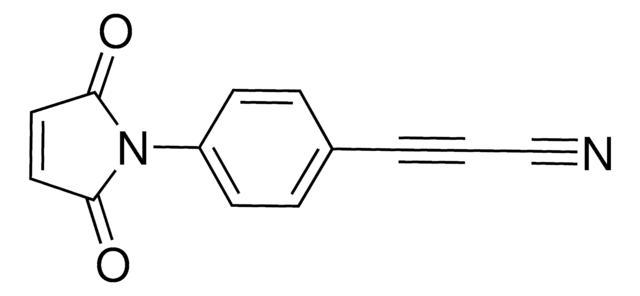809322
1-(2-Aminoethyl)maleimide hydrochloride
Sinónimos:
1-(2-Aminoethyl)pyrrole-2,5-dione hydrochloride
Iniciar sesiónpara Ver la Fijación de precios por contrato y de la organización
About This Item
Fórmula empírica (notación de Hill):
C6H9N2O2Cl
Peso molecular:
176.60
Número MDL:
Código UNSPSC:
12352111
ID de la sustancia en PubChem:
NACRES:
NA.22
Productos recomendados
Ensayo
95%
Nivel de calidad
Formulario
powder
mp
166 °C
grupo funcional
amine
imide
maleimide
cadena SMILES
Cl.N1(C(=O)C=CC1=O)CCN
InChI
1S/C6H8N2O2.ClH/c7-3-4-8-5(9)1-2-6(8)10;/h1-2H,3-4,7H2;1H
Clave InChI
NJQOCRDPGFWEKA-UHFFFAOYSA-N
Descripción general
1-(2-Aminoethyl)maleimide hydrochloride (N-(2-Aminoethyl)maleimide hydrochloride salt) can be prepared from tert-butyl 2-(2,5-dioxo-2,5-dihydro-1H-pyrrol-1-yl)ethylcarbamate.
Aplicación
1-(2-Aminoethyl)maleimide hydrochloride (1-(2-Aminoethyl)-1H-pyrrole-2,5-dione HCl salt) may be used in the preparation of N-propionyl cysteaminylphenol-maleimide-dextran (NPCMD) and 4-nitrophenyl 2-(2,5-dioxo-2,5-dihydro-1H-pyrrol-1-yl)ethylcarbamate.
Palabra de señalización
Warning
Frases de peligro
Consejos de prudencia
Clasificaciones de peligro
Eye Irrit. 2 - Skin Irrit. 2
Código de clase de almacenamiento
11 - Combustible Solids
Clase de riesgo para el agua (WGK)
WGK 3
Punto de inflamabilidad (°F)
Not applicable
Punto de inflamabilidad (°C)
Not applicable
Elija entre una de las versiones más recientes:
¿Ya tiene este producto?
Encuentre la documentación para los productos que ha comprado recientemente en la Biblioteca de documentos.
Los clientes también vieron
Yu Mizote et al.
Journal of dermatological science, 73(3), 209-215 (2013-12-10)
N-propionyl cysteaminylphenol-maleimide-dextran (NPCMD) is a toxic tyrosinase substrate developed to treat melanoma. We investigated the effect of NPCMD on innate immune responses in monocytes. CD14⁺ monocytes and a monocytic cell line, THP-1, were stimulated with NPCMD in vitro. Cytokines in
Pieter van der Veken et al.
Chembiochem : a European journal of chemical biology, 6(12), 2271-2280 (2005-10-29)
Gaining insight into phosphoproteomes is of the utmost importance for understanding regulation processes such as signal transduction and cellular differentiation. While the identification of phosphotyrosine-containing amino acid sequences in peptides and proteins is now becoming possible, mainly because of the
Nuestro equipo de científicos tiene experiencia en todas las áreas de investigación: Ciencias de la vida, Ciencia de los materiales, Síntesis química, Cromatografía, Analítica y muchas otras.
Póngase en contacto con el Servicio técnico












